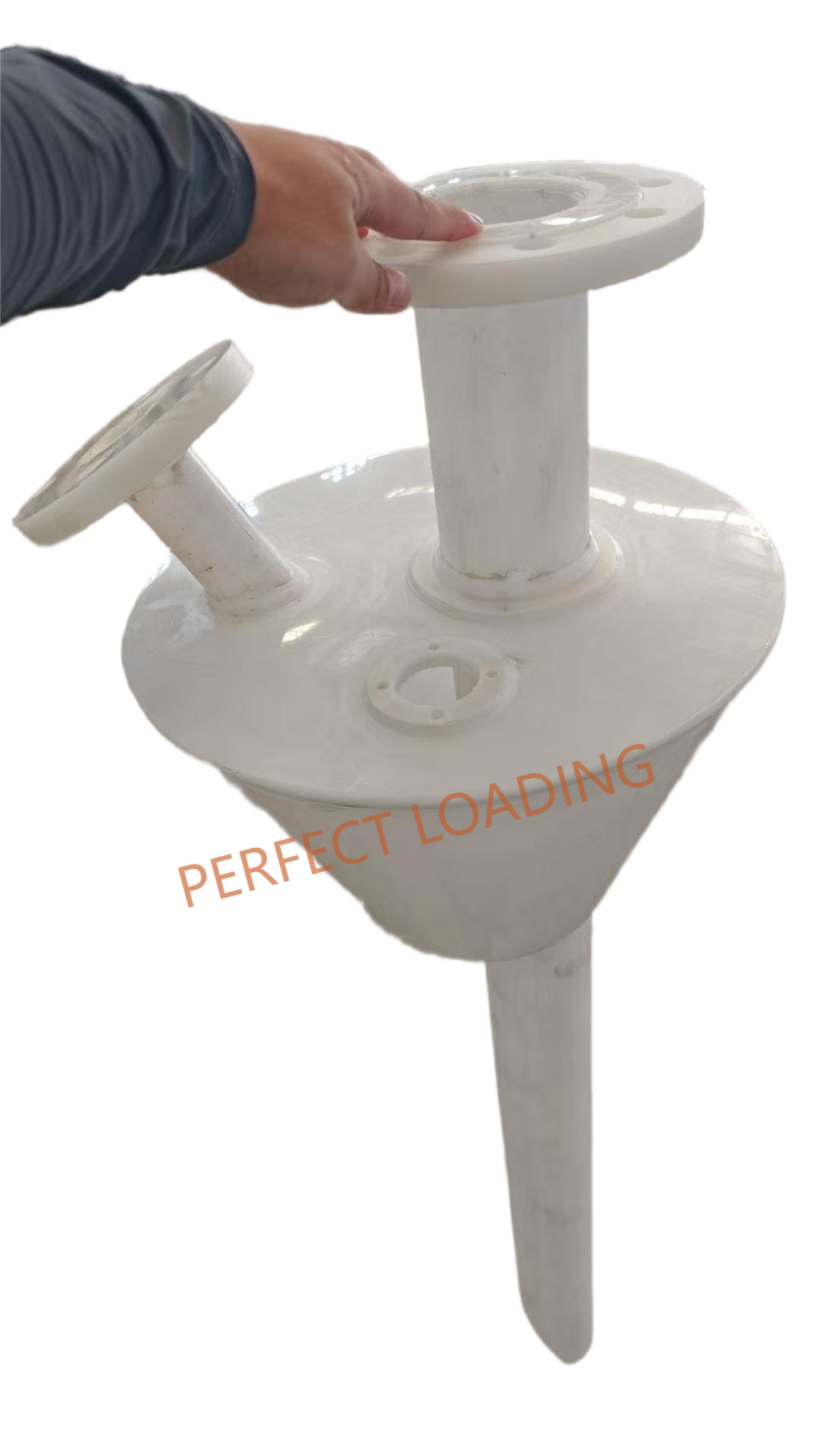4"~12"
PERFECT LOADING
NBR / FKM / PTFE / PP
| Availability: | |
|---|---|
The sealing cone is mounted on the end of the drop tube, which is lowered into the tanker’s hatch during loading or unloading. The cone’s shape—often conical or tapered—allows it to fit snugly into the hatch opening, creating a tight seal against the rim. Some designs include a flexible lip or gasket to enhance the seal, ensuring no gaps for liquid or vapor to escape.
When the loading arm is in action, the sealing cone keeps the fluid contained within the drop tube and tanker, preventing spills or splashes. In vapor recovery setups, the cone works with a vapor return line to capture and redirect emissions back to a recovery system.
They form a tight seal against the tanker’s hatch, preventing liquid leaks and vapor emissions.
Many sealing cones are designed to work with vapor recovery systems, capturing harmful vapors (like VOCs from fuels) to protect the environment and workers.
Built to withstand harsh chemicals, extreme temperatures, and constant use without cracking or degrading.
They’re designed to fit seamlessly onto drop tubes, with quick-connect features for fast setup and removal.
Available in various shapes and sizes to match different hatch designs, ensuring a perfect seal every time.
With robust materials and simple designs, they require minimal upkeep, saving you time and money.
These features make sealing cones a must-have for any loading arm system.
The choice of material depends on the fluid being transferred and the operating environment. Here’s a rundown of the most common materials:
A go-to for petroleum-based fluids like gasoline or diesel. It’s flexible, durable, and resistant to oils, making it perfect for fuel terminals.
Ideal for harsh chemicals like acids or solvents. Viton offers superior resistance to corrosion and high temperatures, perfect for chemical plants.
Virtually inert, PTFE & Polypropylene are used for aggressive chemicals or food-grade liquids. Its non-stick surface also makes it easy to clean, a big plus for sanitary applications.



Polypropylene Sealing Cone Rubber:FKM, Skeleton: SS304L Cone's skeleton: SS304L/SS316
Sealing cones come in a range of sizes and designs to fit different loading arm systems and tanker hatches. Here’s a quick look at the typical specs:
Diameters range from 4” to 12” (100mm to 300mm) to match common hatch sizes. Smaller cones (4”-6”) are used for chemical or food-grade tankers, while larger ones (8”-12”) handle bulk fluids like crude oil.
Most are conical or tapered to ensure a snug fit, but some have flat or flanged designs for specific hatches. Custom shapes are available for non-standard openings.
Designed to handle low to moderate pressures (up to 10 bar or 145 PSI) during loading, as they’re not pressurized components themselves.
Typically -20°C to +120°C (-4°F to +248°F), with materials like Viton or PTFE extending to higher temps (up to +200°C or +392°F).
Many include ports or channels for vapor return lines, critical for fuel or chemical applications.
These specs vary by manufacturer and application, so it’s crucial to match the cone to your loading arm and tanker setup.
· Petroleum and Gas: Used in top-loading arms at fuel terminals to transfer gasoline, diesel, or jet fuel. They prevent spills and capture vapors, keeping emissions in check.
· Chemical Industry: Handle aggressive chemicals like acids or alkalis during tanker loading. The right material (like Viton or PTFE) ensures no corrosion or leaks.
· Food and Beverage: Transfer liquids like syrups, oils, or juices in sanitary conditions. FDA-approved materials like silicone or PTFE keep things clean and safe.
· Pharmaceuticals: Used for high-purity liquids or intermediates, where contamination is a dealbreaker. Sealing cones ensure a sterile, drip-free process.
· Rail and Road Tankers: Ensure safe loading/unloading at depots, minimizing waste and environmental impact.
Each application demands specific features, like vapor recovery for fuels or sanitary materials for food. Sealing cones are the glue that holds these operations together, ensuring every transfer is clean and efficient.
The cone is attached to the drop tube of the loading arm, typically via a clamp, flange, or threaded connection. During operation, the drop tube is lowered into the tanker’s hatch, and the sealing cone presses against the hatch rim to form a tight seal. The operator adjusts the loading arm to ensure proper alignment, and the fluid flows through the drop tube into the tanker.
For vapor recovery, the cone may connect to a vapor return line, channeling emissions back to a recovery unit. The process is quick and intuitive, with most cones designed for tool-free installation or removal.
Sealing cones are low-maintenance, but a little care goes a long way. Here’s how to keep them performing well:
Check for cracks, tears, or wear, especially on the sealing surface. A damaged cone is like a worn-out gasket—leaks are inevitable.
Remove fluid residue or debris to prevent contamination, especially in food or pharma applications. Use compatible cleaners to avoid degrading the material.
Swap out cones showing signs of hardening, cracking, or deformation. Keep spares on hand for quick replacements.
Ensure the cone aligns properly with the hatch to avoid uneven wear or poor sealing.
When not in use, store in a cool, dry place away from UV light or chemicals to extend lifespan.
Sealing cones might seem like a small part of the loading arm, but they're the linchpin that keeps operations safe, efficient, and compliant. They prevent costly spills, reduce environmental impact, and protect workers from hazardous exposure. In industries where every drop counts—whether it’s high-value chemicals or regulated fuels—sealing cones ensure nothing goes to waste.
Their versatility, durability, and ease of use make them indispensable. Plus, with customizable materials and sizes, you can find a cone for any application, from food-grade syrups to corrosive acids. It’s like having a tailor-made solution that fits your needs perfectly, no matter the challenge.
The sealing cone is mounted on the end of the drop tube, which is lowered into the tanker’s hatch during loading or unloading. The cone’s shape—often conical or tapered—allows it to fit snugly into the hatch opening, creating a tight seal against the rim. Some designs include a flexible lip or gasket to enhance the seal, ensuring no gaps for liquid or vapor to escape.
When the loading arm is in action, the sealing cone keeps the fluid contained within the drop tube and tanker, preventing spills or splashes. In vapor recovery setups, the cone works with a vapor return line to capture and redirect emissions back to a recovery system.
They form a tight seal against the tanker’s hatch, preventing liquid leaks and vapor emissions.
Many sealing cones are designed to work with vapor recovery systems, capturing harmful vapors (like VOCs from fuels) to protect the environment and workers.
Built to withstand harsh chemicals, extreme temperatures, and constant use without cracking or degrading.
They’re designed to fit seamlessly onto drop tubes, with quick-connect features for fast setup and removal.
Available in various shapes and sizes to match different hatch designs, ensuring a perfect seal every time.
With robust materials and simple designs, they require minimal upkeep, saving you time and money.
These features make sealing cones a must-have for any loading arm system.
The choice of material depends on the fluid being transferred and the operating environment. Here’s a rundown of the most common materials:
A go-to for petroleum-based fluids like gasoline or diesel. It’s flexible, durable, and resistant to oils, making it perfect for fuel terminals.
Ideal for harsh chemicals like acids or solvents. Viton offers superior resistance to corrosion and high temperatures, perfect for chemical plants.
Virtually inert, PTFE & Polypropylene are used for aggressive chemicals or food-grade liquids. Its non-stick surface also makes it easy to clean, a big plus for sanitary applications.



Polypropylene Sealing Cone Rubber:FKM, Skeleton: SS304L Cone's skeleton: SS304L/SS316
Sealing cones come in a range of sizes and designs to fit different loading arm systems and tanker hatches. Here’s a quick look at the typical specs:
Diameters range from 4” to 12” (100mm to 300mm) to match common hatch sizes. Smaller cones (4”-6”) are used for chemical or food-grade tankers, while larger ones (8”-12”) handle bulk fluids like crude oil.
Most are conical or tapered to ensure a snug fit, but some have flat or flanged designs for specific hatches. Custom shapes are available for non-standard openings.
Designed to handle low to moderate pressures (up to 10 bar or 145 PSI) during loading, as they’re not pressurized components themselves.
Typically -20°C to +120°C (-4°F to +248°F), with materials like Viton or PTFE extending to higher temps (up to +200°C or +392°F).
Many include ports or channels for vapor return lines, critical for fuel or chemical applications.
These specs vary by manufacturer and application, so it’s crucial to match the cone to your loading arm and tanker setup.
· Petroleum and Gas: Used in top-loading arms at fuel terminals to transfer gasoline, diesel, or jet fuel. They prevent spills and capture vapors, keeping emissions in check.
· Chemical Industry: Handle aggressive chemicals like acids or alkalis during tanker loading. The right material (like Viton or PTFE) ensures no corrosion or leaks.
· Food and Beverage: Transfer liquids like syrups, oils, or juices in sanitary conditions. FDA-approved materials like silicone or PTFE keep things clean and safe.
· Pharmaceuticals: Used for high-purity liquids or intermediates, where contamination is a dealbreaker. Sealing cones ensure a sterile, drip-free process.
· Rail and Road Tankers: Ensure safe loading/unloading at depots, minimizing waste and environmental impact.
Each application demands specific features, like vapor recovery for fuels or sanitary materials for food. Sealing cones are the glue that holds these operations together, ensuring every transfer is clean and efficient.
The cone is attached to the drop tube of the loading arm, typically via a clamp, flange, or threaded connection. During operation, the drop tube is lowered into the tanker’s hatch, and the sealing cone presses against the hatch rim to form a tight seal. The operator adjusts the loading arm to ensure proper alignment, and the fluid flows through the drop tube into the tanker.
For vapor recovery, the cone may connect to a vapor return line, channeling emissions back to a recovery unit. The process is quick and intuitive, with most cones designed for tool-free installation or removal.
Sealing cones are low-maintenance, but a little care goes a long way. Here’s how to keep them performing well:
Check for cracks, tears, or wear, especially on the sealing surface. A damaged cone is like a worn-out gasket—leaks are inevitable.
Remove fluid residue or debris to prevent contamination, especially in food or pharma applications. Use compatible cleaners to avoid degrading the material.
Swap out cones showing signs of hardening, cracking, or deformation. Keep spares on hand for quick replacements.
Ensure the cone aligns properly with the hatch to avoid uneven wear or poor sealing.
When not in use, store in a cool, dry place away from UV light or chemicals to extend lifespan.
Sealing cones might seem like a small part of the loading arm, but they're the linchpin that keeps operations safe, efficient, and compliant. They prevent costly spills, reduce environmental impact, and protect workers from hazardous exposure. In industries where every drop counts—whether it’s high-value chemicals or regulated fuels—sealing cones ensure nothing goes to waste.
Their versatility, durability, and ease of use make them indispensable. Plus, with customizable materials and sizes, you can find a cone for any application, from food-grade syrups to corrosive acids. It’s like having a tailor-made solution that fits your needs perfectly, no matter the challenge.
content is empty!